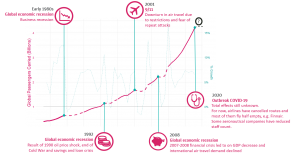We had always intended the final part of this blog series to be an invite to discuss our views of the future of Air Traffic Management at the World ATM Congress in Madrid. The fast spread of coronavirus has, quite rightly, required the cancellation of WAC – so we will have to save up that invite for next year. So where does that leave us?
The role of aviation, providing mobility for passengers and goods, is tightly coupled to a sense of well-being and economic prosperity. At times of crisis, demand for aviation falls. The impact of the current crisis is already swirling through our industry and demand is significantly down. As travel bans are enforced, as cultural and sporting events get cancelled – airlines cancel flights and airports become empty. Coronavirus hastened the demise of FlyBe in the UK – our largest regional carrier; threatening the financial stability of the UK regional airport network. It is too early to predict the full impact – that will depend on the measures taken to stop the spread of the virus; and the longer term economic impact. As IATA have already highlighted, the signs are not good.

History, however, tells us that aviation is robust. The importance of mobility, and the unique nature of aviation in providing fast, convenient connectivity where no other transport mode is possible, has always meant that traffic has returned and then continued to grow. History also suggests that it is hard to predict when traffic returns and that measures taken by ANSPs to reduce costs often taken longer to undo than do. This is because ANSP are quite limited in cost reduction measures – cancelling major system upgrades and reducing staff count seem like quick wins but take a lot of undoing.
When traffic does return this time, ATM must be ready – not only to handle new traffic but to do so in the most sustainable manner possible. As we have discussed throughout the blog series, the future airspace architecture, proposed by SESAR has all the right attributes to support scalability of ATM during a crisis as well as the flexibility to support trajectory based operations such that all airspace users are able to access airspace required for their mission with minimised environmental impact.
The true enabler of the future vision is a common data layer providing synchronised and up-to-date data to all the stakeholders enabling trajectory optimisation to take account of all constraints: airline, airport and ATM.
A common data layer also frees up innovation, collaboration and competition. Above the common data layer, ANSPs are able to access this data in order to collaborate with other ANSPs moving capacity to where it is most needed. Airports and Airlines are able to understand the network and negotiate changes to support their schedules.
Below the common data layer, CNS, AIS and MET providers will be encouraged to compete for the provision of auxiliary services leading to consolidation and cost efficiency. It will also be possible to introduce new technology at a wider scale through common interfaces enabled by the common data layer.
There are barriers to achieving this future vision. They are not technical – this type of architecture is already deployed in other industries. They may be organisational – successful transition will require ANSPs to adopt new ways of thinking, in particular to define their own preferred role and partnerships. They will be regulatory – the current Single European Sky legislation has too much of the current system embedded in its definitions and instruments.
To support this transition, the legislation needs to consider all ANSPs, be they ATS providers, ATM data services providers, CNS, AIS or MET providers, as service providers. It also needs to ensure that ANSPs are rewarded for adding value to the ATM system. Innovation should be the currency; not data. Using regulation to ensure free access to data will enable innovation bringing true digitalisation of the ATM in to reach.
Despite the current crisis, the need to act remains. If aviation is to be part of the carbon-free future, then ATM modernisation is still required. Here at Think Research, we believe the first step is to “free the data”.
See you in Madrid next year; but please let us know what you think sooner by contacting a member of the team on: + 44 (0) 1202 765 654 or send us an email to: info@think.aero


Author: Conor Mullan, Managing Director Author: Paul Ravenhill, Technical Director


Recent Comments